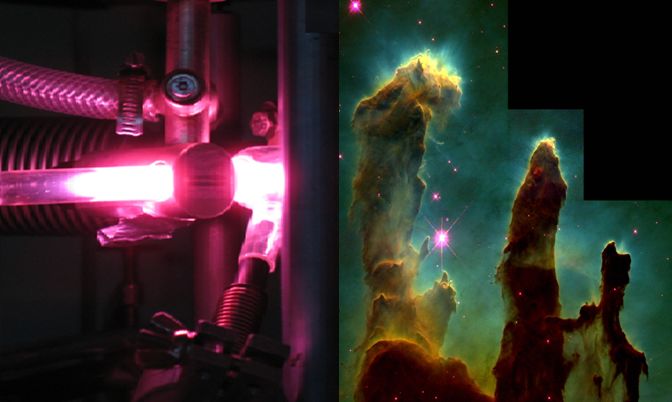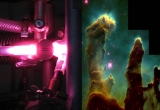Detection of sugars in a laboratory simulation of interstellar and pre-cometary organic matter produced from the photo/thermos chemistry of ices
Ten aldehydes, including two sugars potentially important for prebiotic chemistry, have for the first time been identified in organic residues issued from photochemistry of interstellar ice analogues, produced in the laboratory by the IAS MICMOC/SUGARS experiment.
The MICMOC experiment (Matière Interstellaire et Cométaire: Molécules Organiques Complexes) has a variant (Chiral-MICMOC on the SOLEIL synchrotron) which investigates the spatial conformation (left, L, or right D) of the amino acids produced under the photochemical action of ultraviolet circularly polarized light. The aim of this experiment is to propose an astrophysical scenario for the origin of homochirality observed in biological molecules on the Earth. The MICMOC/SUGARS experiment is another variant of the initial set-up. This fully interdisciplinary approach assembles astrophysicists, molecular physicists, and chemists. It mixes an experimental approach including a strong astrophysical background with the simulation of the evolution of interstellar ice analogues in the laboratory and sophisticated analytical chemistry methods for the detection of molecules of prebiotic interest.
The detection of numerous amino acids in the organic residues produced by the photo/thermo-chemistry of ices has been reported, in part thanks to our collaboration between IAS (Orsay) and INC (Nice). The overall quality of the samples produced by the IAS team « Astrochimie et Origines » has been attested by the use of 13C atoms markers in the original ice samples to avoid any confusion with possible contamination of the samples during manipulation.
Recently, a change in the analytical procedure has allowed the detection of a new family of molecules: the aldehydes. Among them are the two sugars glycolaldehyde and glyceraldehyde, potentially important for prebiotic chemistry. According to a recent study, these molecules may be considered as possible precursors of ribonucleotides (constituents of RNA), in the same manner that amino acids (which are detected within the same experimental protocol) are key molecules for the early formation of proteins. The detection of these molecules in our samples strengthens the scenario of an exogenous delivery of organic molecules essential for starting prebiotic chemistry at the surface of the early Earth.
Finally, if glycolaldehyde is indeed detected in the interstellar medium, that is not the case yet for glyceraldehyde, which can be seen now as a potential target for large modern radioastronomy instruments such as ALMA. Glyceraldehyde could also be proposed for detection in primitive carbonaceous meteorites.
Research paper: P. de Marcellus et al. (2015). Aldehydes and sugars from evolved precometary ice analogues: Importance of ices in astrochemical and prebiotic evolution.
PNAS. DOI : 10.1073/pnas.1418602112 10.1073/pnas.1418602112

Left: UV source for astrochemistry experiments at IAS (picture : P. de Marcellus). Right: the “Pillars of Creation” (in the Eagle nebula) seen by the Hubble Space Telescope (HST, NASA).




